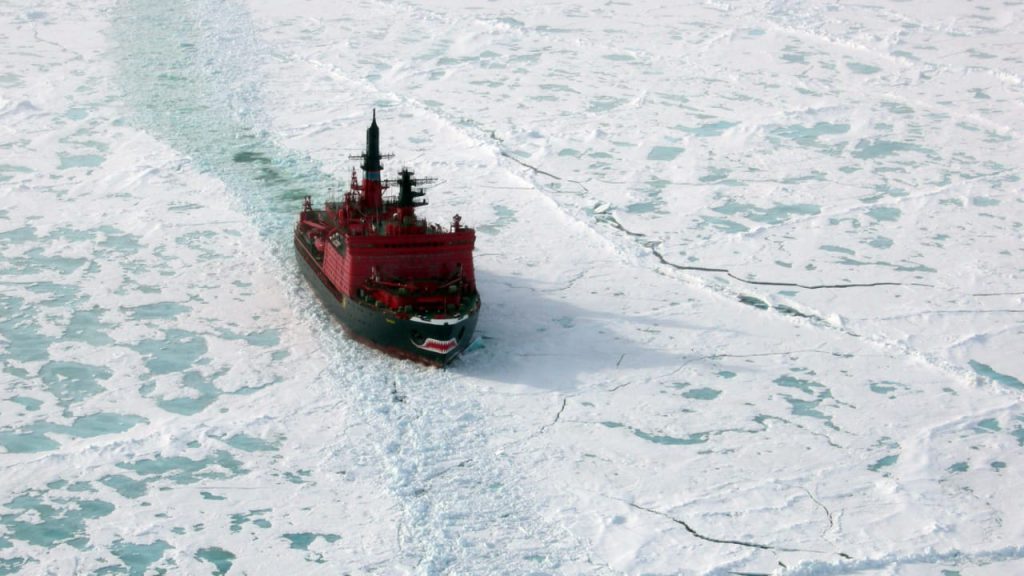Oceans and Engines: A Mahanian Take on Russian Nuclear-powered Icebreaker in the Arctic

Russian nuclear icebreaker, Yamal. Source: Getty Images
The Arctic region is of increasing importance for states directly adjacent to the region, namely Russia, Norway, Finland, Sweden, Denmark, Iceland, Canada, US, engage it with a profound interest in mind. Even so, there are also increasing involvement of extra-regional actors, such as China. Resource-richness and trade opportunities are the two most significant factors contributing to the region’s rising geopolitical rivalry.
It is predicted that the Arctic contained more than 90 billion barrels of untapped oil reserves whilst simultaneously enable intercontinental travel distance to be shorten by up to 40% (Gautier & Moore, 2017; Kornhuber et al., 2023). These potential, however, are still not fully realized due to thick layer of ice that cover the arctic sea for the most part of the year. Dissipating such hindrance requires the assistance of a specifically-designed ship called the “icebreaker”. The nuclear-powered variant of the ship had rendered it virtually immortal in oceanic exploration and giving its possessor greater control in sea dominance.
In contrast to the South Pole, which is a single large landmass (or rather, ice-mass), the North Pole or the Arctic is characterized by intermittent and shifting ice sheets, varying with climate. The Arctic are also much closer to countries and population denters, as it touched the Eurasian and North American mainland with hundred and thousands of kilometers of shoreline. Due to its polar climate, however, sailing through this archipelagic geographical construct has proven to be difficult undertaking. Outside the summer season, it is estimated that there are over five million km2 ice sheets covering the Arctic at any given time.
Such geography is an interesting undertaking for geopolitical and sea enthusiast, such as Alfred T. Mahan that proposed a perspective on “Sea Power.” A naval military strategist at heart, Alfred T. Mahan (1890) argues states achieved great power status by way of increasing the quality of their navy. Although the concept of quality might relates to many, the nuclear-powered icebreakers (NPIs) may be perceived as an increase to quality of naval power. This article also argue that the very role that NPIs could fulfill in Arctic’s geopolitics may revamp said thesis.
“Superpowers Lived in Three Words:” Nuclear Powered Icebreakers’ Game-changing Abilities
The utilization of the Arctic’s maritime trade routes is primarily driven by a basic economic logic, which is to seek the most cost-effective way in conducting trade. By 2050, it is forecasted that 5% of global shipping would filled the Arctic waterways (Humpert, 2011). It has been proven also that ten days is the time needed for ships to pass through the Arctic from Europe to East Asia (Abe & Otsuka, 2019). If climate change were to occur in much intense manner, it is predicted that a 52% trade volume increase will occur between Arctic ports (Sui et al., 2021). These numerical predictions showcase a great economic incentives that stakeholders could attain in the Arctic. However, the problem of sea ice carries much more much more complex consequences than conventional tropical logistics endeavors (Yu et al., 2021). These incentives and dangers serves as push factors for multinational logistical companies to rent the service of icebreakers.
Icebreakers come in many types, specifications, and names across the centuries of polar exploration. After coal and steam became obsolete, diesel-powered became the norm for states employing this kind of ship. From the first commissioned diesel-powered icebreaker—the Swedish Ymer—which ran at 9000 horsepower, the Canadian John G. Diefenbaker would eventually tower that horsepower count five-fold. As the thing stands, such an icebreaker could only last for around two months before needing to refuel (Staalesen 2022). Facing that, therefore, stakeholders need to effectively possess accessible refueling infrastructures or risk being stranded in a complicated hazardous situation. The Soviet Union had foreseen the possibility of such circumstances, so it developed nuclear-powered icebreakers to deal with such hindrances.
Today, no country other than the Russian Federation owns actively operating nuclear-powered icebreakers (Domonoske, 2016). This advantageous position in military and economical fronts Russia has compared to the likes of the United States and Canada holds tremendous leverage for the country. For once, it had already developed a “multi-purpose” diesel-powered icebreaker, which is said to possess military capabilities in its hull (Nilsen, 2016). Coupled with a single clearance regime of passing through the NSR-as opposed to other Arctic passages-global stakeholders may be much more reliant on Russia’s icebreaking capabilities. The burgeoning dependency on Russia’s naval power would allow it to enhance its geopolitical standings in the Arctic. This eventual consequence perfectly studies how Alfred T. Mahan’s “sea power” thesis works.
One Thing I Can’t Outgrow: Mahan’s Sea Power Classical Analysis
The sea power thesis consists of two parts: (1) the pillars; and (2) the elements. Mahan (1890, in Holmes & Yoshihara, 2006) delineates the pillars as (1) production, the necessity to conduct trade; (2) shipping, favorable conditions which allows production to take place; and (3) colonies, bases capable of facilitating shipping. Mahan added that a robust naval strategy, acting upon such pillars, are prerequisites that led states to achieve greater financial control. Russia’s furious development of its icebreakers paints the strategic considerations it has taken regarding increasing commercial activities in the Arctic. Russia has also implemented the shipping pillar in its Arctic strategy by constructing conditions that favor global economic actors. Furthermore, as the following paragraph suggests, it outperformed competitors in developing a measure to bypass the need for “colonies”, which was crucial for colonial powers in Mahan’s era.
The postmodern idea of “colonies” is analogous to “islands” in contemporary geostrategy. Scott (2021) argues that it could be translated to bases with functions of refueling stations and multi-purpose outposts. Albeit international law’s role in establishing territorial rights for coastal nations, the complex nature of the Arctic’s geography allows no country to control physical islands effectively, moreover, sea ice. Employing an element of garnering sea power, physical conformation, to face such reality is one of the measures Russia showcased by investing in nuclear-powered icebreakers. The long life span of NPIs-with some going 25 years without refueling-practically diminishes the importance of colonies/islands in Arctic geopolitics. Therefore, Russia’s powerful and versatile Arctic fleet has given it leverage over other actors’ interests, mainly when dealing with strategic situations in the region.
Russian NPIs’ policy is a testament to Mahan’s other sea power elements, particularly population and national character. The character variable in interstate relations might be conceptually challenging to understand. Mahan’s thinking, however, practically denotes the state’s interest in conducting sea-based trade (Patricia & Satya, 2022). Russia showcased such desire when it exported 275.000 barrels of crude oil extracted from the Arctic to China even though Europe had sanctioned its hydrocarbon industry (Humpert, 2023). Utilizing NPIs to reroute petroleum export may also mark Russia’s desire to tend to its domestic needs for funds. Particularly with a war it engages in, ensuring the survivability of its internal economy is a priority if it wishes to maintain, at the very least, the docile nature of its repressed population.
This is (not) the Last Falsetto: NPIs as New Reality in Mahan’s Geostrategy
Being the only wielder of NPIs in the geographically complex Arctic had given the Russian Federation significant leverage over its regional competitor. First, the assistance of Russia’s NPIs significantly reduced the qualms of passing commercial ships being entrapped in Arctic sea ice. Second, Russia virtually diminished the requirement for colonies in projecting excellent power status through its Arctic naval force. Third, with multi-purpose diesel-powered icebreakers capable of carrying military equipment, it is only a matter of time before such a design is implemented in a nuclear-powered setting. From a Mahanian perspective, those factors effectively maintain Russia’s great power status in the Arctic.
Conceptually, Russia’s undertaking showcases a Mahanian perspective and the impetus to rethink it. At a glance, Russia’s Arctic naval strategy had coincided with the pillars of Mahan’s thinking. It understood the burgeoning global trade’s necessity of using the Arctic and creating conditions that make it economically viable or profitable. Russia’s strategy of enhancing its sea power also included the elements of population and national character by rerouting its petroleum exports to China through the Arctic. NPIs’ autonomous long period of duty should force geopolitical analysts to rethink the idea of colonies in the contemporary quest for great power status in the geopolitics of the ocean.
NIKI mentioned, “but I’m pouring them into the ocean, and I’m starting my engine, and I’m letting go.” However, Russia pours more of its NPIs into the Arctic Ocean, starting their engines as we speak. Nevertheless, letting go of the resulting geopolitical discourse is not the best option for many stakeholders.
References
Abe, M., and N. Otsuka, 2019. “Northern Sea Route (NSR) as a Major Transport Route: Opportunities and Challenges”, Asian Transport Studies, 5 (4): 617-634.
Domonoske, C., 2016. “Russia Launches World’s Biggest, Most Powerful Icebreaker” [daring]. Extracted from https://www.npr.org/sections/thetwo-way/2016/06/16/482288188/russia-launches-worlds-biggest-most-powerful-icebreaker [Accessed by 26 February 2023].
Gautier, D. L. and T. E. Moore, 2017. “Introduction to the 2008 Circum-Arctic Resource Appraisal (CARA) Proffesional Paper”, U. S. Geological Survey Professional Paper, No. 1824-A.
Holmes, J. R., and T. Yoshihara, 2006. “China and the Commons: Angell or Mahan?”, World Affairs, 168 (4): 172-190.
Humpert, M., 2011. “The Future of the Northern Sea Route – A ‘Golden Waterway’ or a Niche Trade Route,” The Arctic Institute, 15 September.
Humpert, M., 2023. “Russia Reroutes Arctic Oil To China and India as Result of EU Sanctions”, High North News, 16 January.
Kornhuber, K. et al., 2023. “The Disruption of Arctic Exceptionalism: Managing Environmental Change in Light of Russian Aggression”, DGAP Report, No. 2.
Mahan, A. T., 1890. The Influence of Sea Power upon History, 1660-1783. Little Brown.
Nilsen, T., 2016. “Announces tender for fantasy-giant icebreakers”, The Barents Observer, 16 September.
Patricia, and P. A. N. I. P. Satya, 2022. “Questioning China Questioning China’s Peaceful De eaceful Development: A Mahanian Sea elopment: A Mahanian Sea Power Analysis of Blue Water Navy Accumulation”, Global: Jurnal Politik Internasional, 24 (2): 252-276.
Scott, D., 2021. “Small Island Strategies in the Indo-Pacific by Large Powers”, The Journal of Territorial and Maritime Studies, 8 (1): 66-85.
Staalesen, A., 2022. “Russia’s Viktor Chernomyrdin Icebreaker on Maiden Voyage to Arctic” [online]. Extracted from https://www.rcinet.ca/eye-on-the-arctic/2022/05/05/russias-viktor-chernomyrdin-icebreaker-on-maiden-voyage-to-arctic/ [Accessed by 26 February 2023].
Sui, Y. et al., 2021. “Trade Volume Prediction Based on a Three-stage Model when Arctic Sea Routes Open”, Symmetry, 13 (610).
Yu Y. et al., 2021. “Evaluation model and management strategy for reducing pollution caused by ship collision in coastal waters”, Ocean & Coastal Management, 203: 105446.
Philipus Mikhael Priyo Nugroho is a student at Universitas Airlangga. He can be found on Instagram with username @miko.khael








